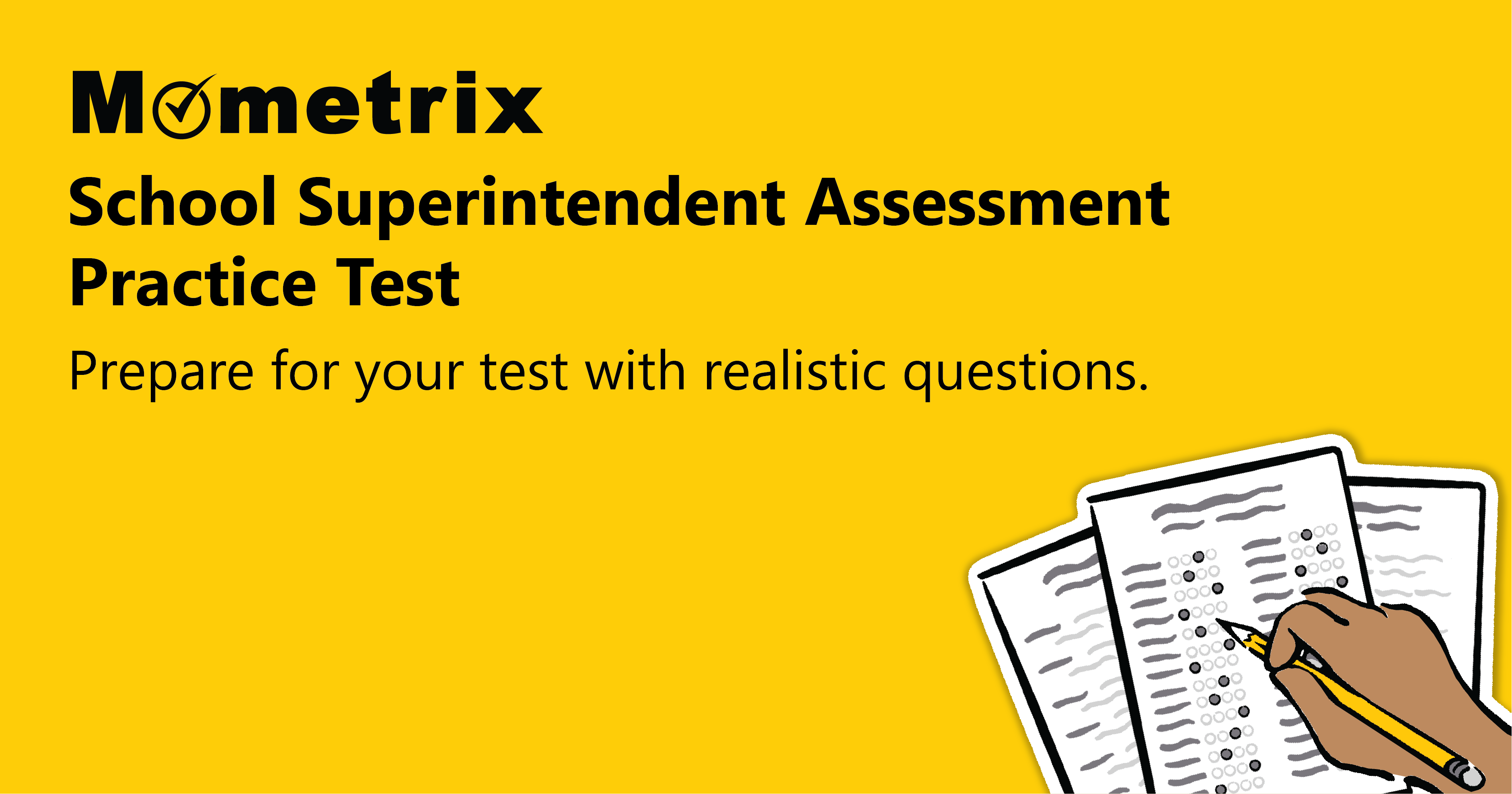The School Superintendent Assessment (SSA) evaluates candidates applying for entry-level superintendent positions. It is designed to measure the knowledge and skills necessary for candidates to perform the duties required by this position in a competent, authoritative manner, with proper leadership.
Click “Start Test” above to take a free School Superintendent Assessment practice test, and check out our premium-quality School Superintendent Assessment test prep resources by clicking the links below!
About the SSA Exam
The School Superintendent Assessment (6991) is a computer-delivered evaluation, requiring you to answer the questions and prompts that you read on the computer screen.
The entire 3-hour exam contains 120 questions that are selected-response and 3 questions that are constructed-response.
For constructed-response questions, you will write out your response.
The majority of the questions are multiple-choice, where you will select one single answer that bests suits the question. However, there are interactive questions that require a little more than a single answer selection. These include:
- Selecting more than one answer. Some of the answers will require you to select the oval in front of the correct response and click on it. You may also see boxes in front of the correct answer and you are required to click on the box
- Typing text into an answer box
- Selecting a location or section of a graph or map
- Selecting sentences within a passage instead of choosing from a list of options
- Using a drop-down menu to select answers
- Dragging and dropping the correct answer into a specified location on the screen
SSA Exam Outline
The SSA exam is divided into seven sections.
1. Strategic Leadership
This section covers eight principles.
- Knowledge of the core values as they pertain to the culture of the district
- Ability to apply a variety of strategies to help develop an understanding and partner relationship between the district and the community
- Ability to engage stakeholders in the development of the mission, vision, and core values of the district, as well as the understanding you have of how to promote academic success and protect the well-being of each student
- Understand how the needs of students can create a need for an adjustment that stakeholders may need to implement in the vision, core values, and mission
- Ability to use a systematic approach for the development of plans that will improve the school and the district
- Knowledge that is required to develop a strategic plan that will enable to school or district to achieve the vision
- Knowledge of how to manage uncertainty and risk to ensure the success of the district in improvements
- Knowledge and skills required to make necessary adjustments to plans based on the needs of the students
2. Instructional Leadership
This portion of the test evaluates your knowledge and skills in implementing the following:
- Curriculum and instruction
- Assessment and accountability
- Climate and culture for staff
3. Climate and Culture Leadership
In this section, you will find questions related to the following:
- Equity and cultural responsiveness
- Community care and support for students
- Policy, advocacy, and governance
4. Ethical and Policy Leadership
In this section, you will find questions related to the following:
- Your ability to understand and implement ethical professional relationships with the staff and administrators of the schools in the district.
- You must be able to demonstrate your passion for integrity, and your ability to be fair.
- You must demonstrate that the student is the main focus of each decision you make.
- You must show that you practice responsible stewardship of the resources you would be in charge of.
5. Organizational Leadership
In this section, you will find questions related to the following:
- Knowledge and ability to plan for and manage staff needs
- Display your knowledge of recruiting practices
- Demonstrate your knowledge of how to retain staff
- Demonstrate your knowledge of local, state, and federal laws
- Demonstrate your knowledge of proper procedures that should be followed in staff discipline
- Demonstrate your knowledge of how to mentor new personnel
- Knowledge about the development of staff members, including their skills and abilities
- Knowledge of methods required to establish and promote a culture of continuous learning and skill development among staff members
- Ability to provide actionable feedback using valid research-anchored systems
6. Community Leadership
In this section, you will find questions related to community engagement, which covers the following:
- Knowledge of how to communicate with families and members of the community
- Ability and knowledge in helping the community understand the local policies, the state, and federal laws, and how they affect your district
- Ability to highlight the accomplishments of the district and address where the district can make improvements
- Knowledge of methods used to create opportunities for schools and communities to join forces in support of the students
- Ability to be transparent so you can build trust among stakeholders
- Knowledge of methods used to establish a positive relationship with local media
- Knowledge and ability to maximize the resources available to the district
- Knowledge of social media platforms and the proper way to utilize them
- Knowledge and understanding of the district crisis management plan and how and when to implement it to protect staff and students
7. Integrated Knowledge and Understanding
In this section, you will find questions related to your ability to use strategic leadership methods and understand the climate and culture leadership roles the superintendent plays in the district.
You must also demonstrate your knowledge of organizational leadership abilities.
Registering for the Exam
You will need to create an SLS account that allows you to register for the evaluations you need to pursue employment opportunities related to education. The fee for registration is $350.00.
This examination is available to take in your own home. You can take the test any day of the week if you choose to take it at home.
The exam is also available through test centers, universities, and other authorized locations. On the SLS website, you will find a list that includes all of the possible testing locations, test times, and pertinent information about the SSA. The exam code for the SSA is 6991.
Canceling Registration
If you discover that you are going to be unable to take the test on a registered day you may cancel as long as the cancelation occurs no less than three days before the registered date. The three days do not include the testing day. If you are scheduled to take the test on a Friday, you must cancel your registration no later than Tuesday at 11:59 pm.
If you do cancel in the allotted time, there is a chance that you may be given a partial refund for the test fees.
If you do not attend your registered test session, no refund will be given to you.
Fees
In addition to the $350.00 test fee, there are fees that will apply if you request one or more of the following special services.
| Special Service | Fee |
|---|---|
| Test date and/or test center change | $40 |
| Registration via telephone | $35 |
| Additional score report (per report) | $50 |
| Score review | $65 |
Test Day
Items to Bring with You to the Testing Center
- Your admission ticket
- A valid form of identification with a photo
- A mask or face covering
Items to NOT Bring with You to the Testing Center
- Phones
- Watches
- Jewelry other than a wedding or engagement ring
- Wearable technology
Items for At-home Testing
If you are taking the test at home, you will need:
- A desktop or laptop computer (you may NOT use a Chromebook, a tablet, or a smartphone)
- Windows operating system that is windows 8 or above.
- If you have a MAC you will need a Mac operating system that is 10.5 or above.
- You must use either Chrome or Firefox as your browser.
- Only one screen or monitor (dual or multiple screens are not permitted)
- A microphone
- A built-in camera or a webcam (it must be able to show the test proctor a 360-degree view of the room you are testing in, and the proctor will need to see the surface area of the tabletop or desk you are working from)
Other At-home Testing Requirements
- You may not use headphones or a headset.
- You must be alone in the room.
- You may not take the test in a public area.
- All doors to the room where you are testing must be closed before the test begins.
- You may use one small desktop whiteboard but may not use paper to take notes. At the end of the test, all of your notes must be erased.
- Your ears must be visible.
- You may not wear a facemask.
- You must be seated in a standard chair. No overstuffed chairs, lying on beds, or bean bag chairs are allowed.
- You may not eat or drink during the test.
- Your computer must be on a table or similar surface and cannot be positioned on your lap.
How the Exam is Scored
Depending on which state you take your exam in, the scoring requirements differ.
| State | Score Required |
|---|---|
| Arkansas | 157 |
| Colorado | 162 |
| Delaware | |
| Indiana | |
| Kansas | |
| Louisiana | |
| Maine | |
| Nebraska | |
| New Jersey | |
| Pennsylvania | |
| Rhode Island | |
| South Carolina | |
| South Dakota |
Receiving Your Scores
Your scores are accessible through your SLS account page.
For multiple-choice questions, the scoring is complete on the day of the exam, but for written responses, the scoring may not be completed for up to 10 days.
Study For the SSA Exam the Best Way
How to Study Effectively
Your success on SSA test day depends not only on how many hours you put into preparing but also on whether you prepared the right way. It’s good to check along the way to see whether your studying is paying off. One of the most effective ways to do this is by taking School Superintendent Assessment practice tests to evaluate your progress. Practice tests are useful because they show exactly where you need to improve. Every time you take a free SSA practice test, pay special attention to these three groups of questions:
- The questions you got wrong
- The ones you had to guess on, even if you guessed right
- The ones you found difficult or slow to work through
This will show you exactly what your weak areas are and where you need to devote more study time. Ask yourself why each of these questions gave you trouble. Was it because you didn’t understand the material? Was it because you didn’t remember the vocabulary? Do you need more repetitions on this type of question to build speed and confidence? Dig into those questions and figure out how you can strengthen your weak areas as you go back to review the material.
Answer Explanations
Additionally, many SSA practice tests have a section explaining the answer choices. It can be tempting to read the explanation and think that you now have a good understanding of the concept. However, an explanation likely only covers part of the question’s broader context. Even if the explanation makes sense, go back and investigate every concept related to the question until you’re positive you have a thorough understanding.
Comprehend Each Topic
As you go along, keep in mind that the School Superintendent Assessment practice test is just that: practice. Memorizing these questions and answers will not be very helpful on the actual test because it is unlikely to have any of the same exact questions. If you only know the right answers to the sample questions, you won’t be prepared for the real thing. Study the concepts until you understand them fully, and then you’ll be able to answer any question that shows up on the test.
Strategy for SSA Practice
When you’re ready to start taking practice tests, follow this strategy:
- Remove Limitations. Take the first test with no time constraints and with your notes and School Superintendent Assessment study guide handy. Take your time and focus on applying the strategies you’ve learned.
- Time Yourself. Take the second practice test “open book” as well, but set a timer and practice pacing yourself to finish in time.
- Simulate Test Day. Take any other practice tests as if it were test day. Set a timer and put away your study materials. Sit at a table or desk in a quiet room, imagine yourself at the testing center, and answer questions as quickly and accurately as possible.
- Keep Practicing. Keep taking practice tests on a regular basis until you run out of practice tests or it’s time for the actual test. Your mind will be ready for the schedule and stress of test day, and you’ll be able to focus on recalling the material you’ve learned.
FAQs
Q
What is the School Superintendent Assessment (SSA)?
A
The School Superintendent Assessment (SSA) is a test that is taken by candidates who are applying for entry-level superintendent jobs. It evaluates the candidates’ knowledge and skills regarding proper leadership, authoritative manner, and overall competency,
Q
How long is the exam?
A
The SSA has a time limit of 3 hours.
Q
How many questions are on the exam?
A
There are 123 questions on the exam. Three of these questions are constructed-response questions, while the remaining 120 are selected-response questions.
Q
How much does the exam cost?
A
The test fee for the SSA is $350.00.
Q
What types of questions are on the exam?
A
On the School Superintendent Assessment (6991), there are two types of questions: constructed-response and selected-response.
Q
When will I receive my scores?
A
You scores for the selected-response questions will be available as soon as you complete the test. Scores for the constructed-response questions will be available around 2 weeks after you complete the test.
Mometrix Test Preparation is not affiliated with or endorsed by any official testing organization. All organizational and test names are trademarks of their respective owners.



